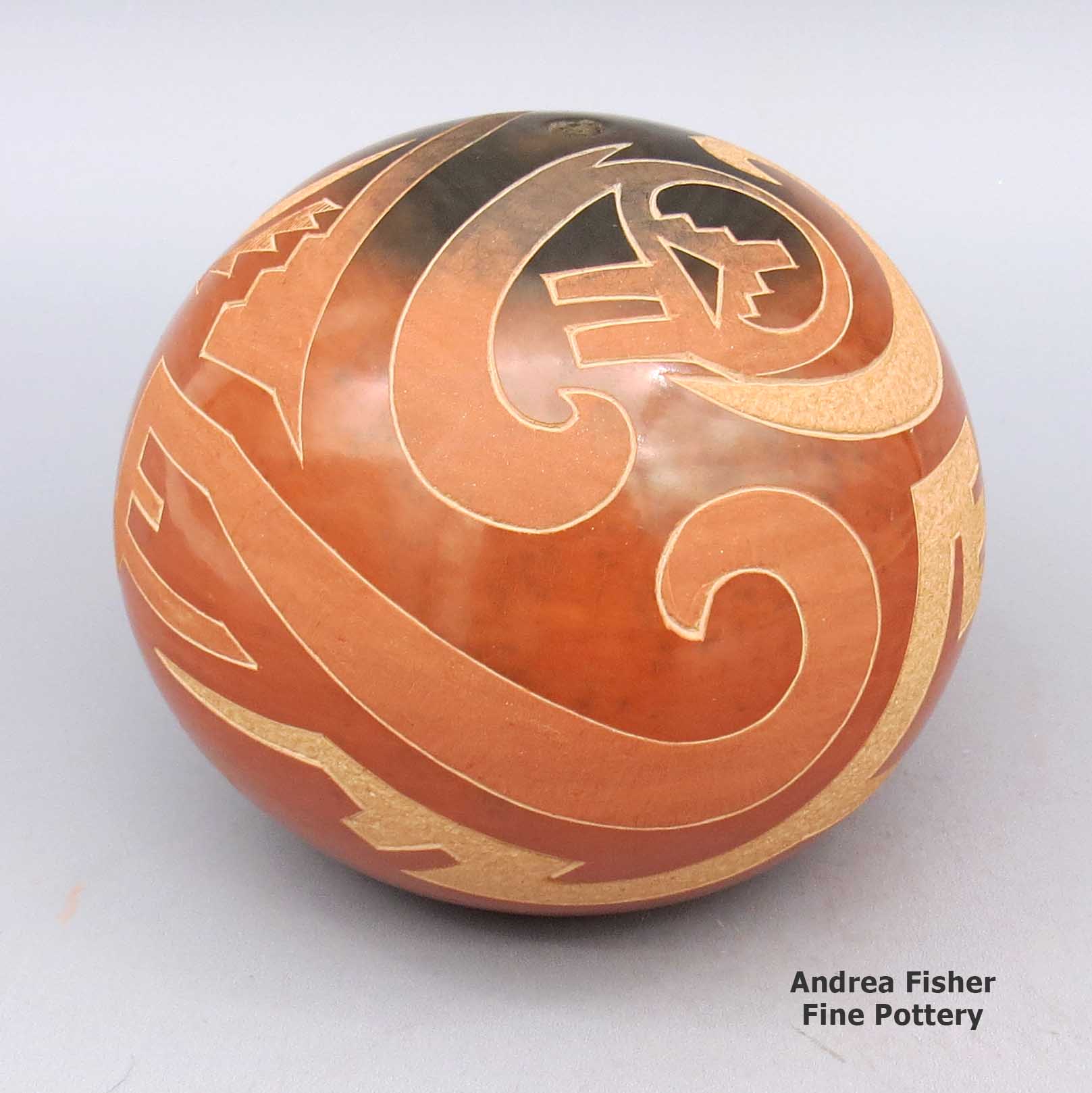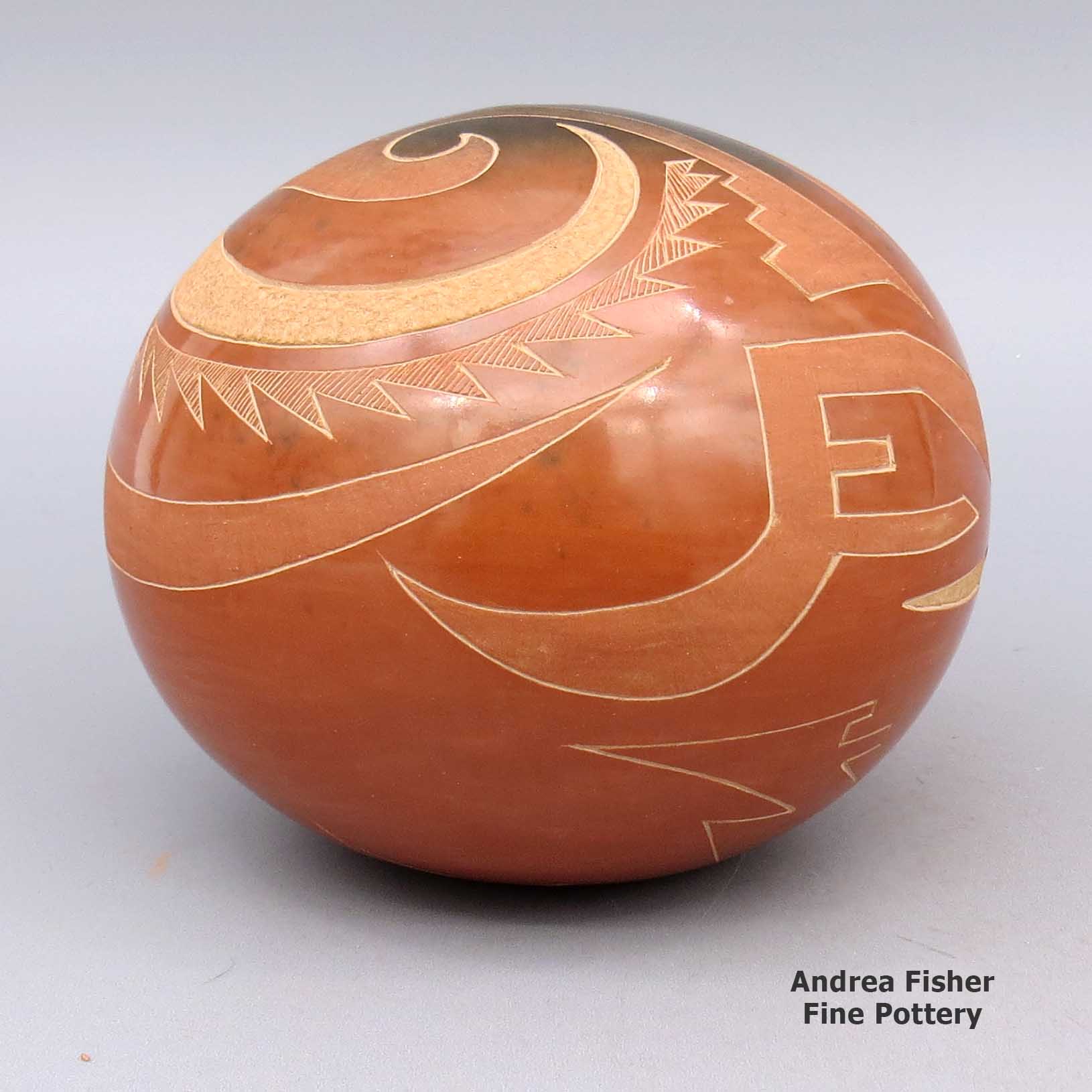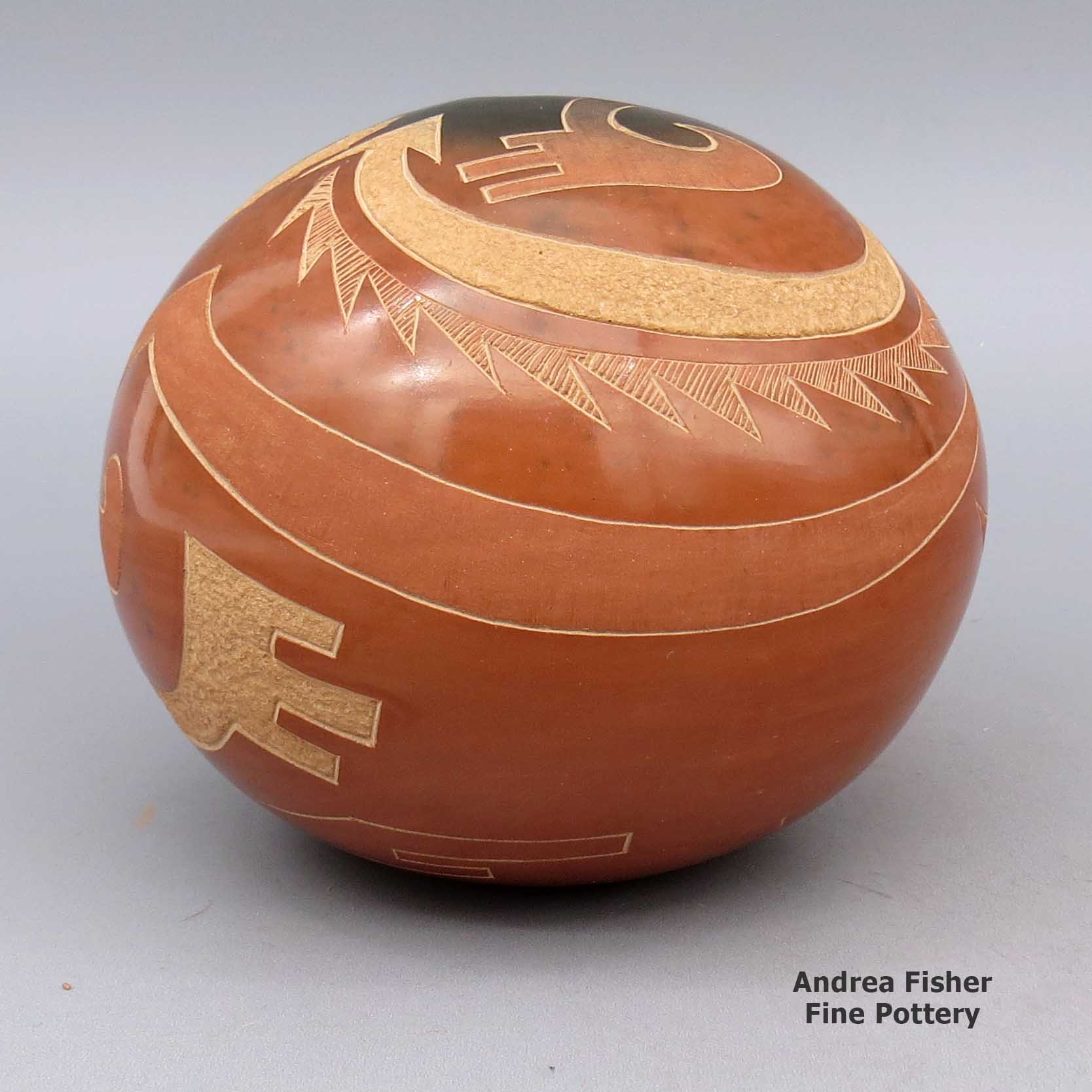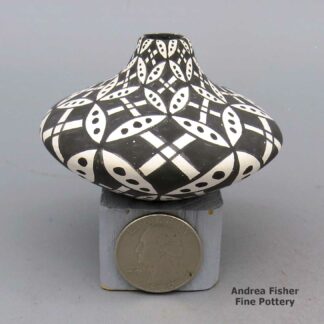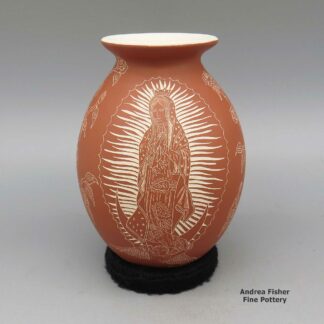| Dimensions | 4 × 4 × 3.5 in |
|---|---|
| Condition of Piece | Very good, sticker residue and stain on bottom |
| Signature | Jody |
Jody Folwell, lksc2l316: Red seed pot with black spot and sgraffito geometric design
$795.00
A red seed pot with a black spot and a sgraffito geometric design
In stock
Brand
Folwell, Jody
Jody balanced that traditional learning with studies in history and political science at the University of New Mexico, finishing with both a BA and an MA. She became an educator and lecturer from the early 1960s through the early 1970s. In 1974 that Jody retired from that and began making pottery full time.
Early in her career Jody moved away from traditional Santa Clara blackware and redware to create buffware with new forms, styles and colors. She does engraving, incising, carving, cut-outs and painting. Her pottery usually has a political or social message to it, whether that message be about women's rights, children's dreams or whimsical pop art.
In 1987 Jody was chosen as a top contemporary Indian artist by the Southwest Museum in Los Angeles for their major exhibit "Eight Indian Artists II." Among the other artists in the exhibit were Apache sculptor Bob Haozous, Winnebago potter Jacquie Stevens, Navajo painter Clifford Beck, and others. The experience led to years of collaboration with Bob Haozous, son of Apache sculptor Alan Houser.
Jody learned the traditional craft from her mother Rose and she passed that teaching on to her daughters, Polly Rose Folwell and Susan Folwell.
Some Exhibits that featured Jody's work
- Something Old, Something New, Nothing Borrowed: New Acquisitions from the Heard Museum Collection. Heard Museum. Phoenix, Arizona. April 2, 2011 - March 18, 2012
- Mothers & Daughters: Stories in Clay. Heard Museum. Phoenix, Arizona. January 10, 2009 - January 10, 2010
- Choices and Change: American Indian Artists in the Southwest. Heard Museum North. Scottsdale, Arizona. June 20, 2007 - April 2012
- Breaking the Mold: The Virginia Vogel Mattern Collection of Contemporary Native American Art. Denver Art Museum, Denver, CO. October 2006 - July 2007
- Breaking the Surface: Carved Pottery Techniques and Designs. Heard Museum. Phoenix, Arizona. October 2, 2004 - October 3, 2005
- The Collecting Passions of Dennis and Janis Lyon. Heard Museum. Phoenix, AZ. May 2004 - September 2004
- Decidedly Diva: Part One, Jody Folwell, Polly Rose Folwell, Susan Folwell. Modo Gallery. Hudson, NY. October 11, 2003 - November 1, 2003
- Changing Hands: Art Without Reservation: Contemporary Native American Art from the Southwest. 2002-2003 Traveling exhibition planned for the following venues: American Craft Museum, New York, NY, 5/9/2002-9/15/2002; Museum of Texas Tech University, Lubbock, TX, 10/13/2002-1/5/2003; Philbrook Museum of Art, Tulsa, OK, 1/19/2003-3/16/2003
- Jody Folwell - Santa Clara: New Works in Clay. Faust Gallery. Scottsdale, AZ. January 31, 2002 - February 7, 2002
- Hold Everything! Masterworks of Basketry and Pottery from the Heard Museum. Heard Museum. Phoenix, Arizona. November 1, 2001 - March 10, 2002
- Images, Artists, Styles: Recent Acquisitions from the Heard Museum Collection. Heard Museum North. Scottsdale, Arizona. July 2001 - January 2002
- The Legacy of Generations: Pottery by American Indian Women. Heard Museum. Phoenix, AZ. February 14, 1998 - May 17, 1998
- The Legacy of Generations: Pottery by American Indian Women. The National Museum of Women in the Arts. Washington, DC. October 9, 1997 - January 11, 1998
- Recent Acquisitions from the Herman and Claire Bloom Collection. Heard Museum. Phoenix, Arizona. January 11, 1997 - July 1997
- Fifth Annual Hollywood Premiere. Four Seasons Hotel, Los Angeles, CA. November 23-24, 1991
- Fourth Annual Hollywood Premiere. Four Seasons Hotel, Los Angeles, CA. November 17-18, 1990
- From This Earth. Museum of New Mexico. Santa Fe, NM. July 1, 1990 - August 30, 1990
- First Annual Indian Arts and Crafts Show: A Juried Competition. Univ. of Kansas Museum of Anthropology. Lawrence, KS. September 16, 1989 - October 28, 1989
- The Pottery of Surprise: New Works by Jody Folwell. Gallery 10, Scottsdale, AZ. March 9, 1989 - March 15, 1989
- Eight Artists II: Contemporary Indian Art at the Southwest Museum. Southwest Museum of the American Indian. Los Angeles, CA. September 27, 1987 - January 5, 1988
- Jody Folwell, Elizabeth Medina, Barbara & Joe Cerno. Gallery 10. Scottsdale, AZ. January 22, 1987 - February 3, 1987
- Everlasting: Four Nationally Prominent Artists. Gallery 10. Scottsdale, AZ. March 6, 1986 - March 19, 1986
- The Santa Fe Indian Market Expanding Exhibit. Morning Star Gallery. Santa Fe, NM. July 26, 1985 - August 31, 1985
- Women of Sweetgrass, Cedar and Sage. Gallery of the American Indian Community House. NY. June 1, 1985 - June 29, 1985
- Indian Market East. Gallery 10. New York, NY. April 12, 1984 - April 28, 1984
- The Ceramics of Grace Medicine Flower & Jody Folwell. Gallery 10. Scottsdale, Arizona. February 24, 1983 - March 9, 1983
- Jody Folwell: Contemporary Pottery. Gallery 10. Scottsdale, Arizona. February 8, 1981 - February 19, 1981
- American Indian Art in the 1980s. The Native American Center for the Living Arts. Niagara Falls, New York. 1981
- Rising Stars. Gallery 10. Scottsdale, AZ. February 8, 1980 - February 27, 1980
- 1978 Heard Museum Guild Indian Arts and Crafts Exhibit. Heard Museum. Phoenix, Arizona. November 24, 1978 - December 2, 1978
- 1977 Heard Museum Guild Indian Arts and Crafts Exhibit. Heard Museum. Phoenix, Arizona. November 25, 1977 - December 3, 1977
Some Awards Jody has earned
- 2018 Santa Fe Indian Market: Native American Art Magazine Editor's Choice Award
- 2018 Santa Fe Indian Market, Classification II - Pottery, Division E - Contemporary Pottery, Any Form or Design, Using commercial clays/glazes, all firing techniques: Best of Division
- 2018 Santa Fe Indian Market, Classification II - Pottery, Division E - Contemporary Pottery, Any Form or Design, Using commercial clays/glazes, all firing techniques, Category 907 - Painted, any form: First Place
- 2018 Santa Fe Indian Market, Classification II - Pottery, Division E - Contemporary Pottery, Any Form or Design, Using commercial clays/glazes, all firing techniques, Category 907 - Painted, any form: Shared Second Place with Diego Romero
- 1993 Santa Fe Indian Market. Classification II - Pottery, Division G. Non-traditional, sgraffito, w/o stones, any color except black, Third Place
- 1989 Indian Arts and Crafts Show: a Juried Competition, Pottery: First Place. University of Kansas Museum of Anthropology. Lawrence, Kansas
- 1988 Santa Fe Indian Market. Classification II - Pottery, miscellaneous, Second Place
- 1987 Gallup Inter-Tribal Ceremonial, Classification IV, Pottery, Bowl, Plate: Best in Classification
- 1987 Gallup Inter-Tribal Ceremonial, Classification IV, Pottery, Bowl, Plate: Best in Category
- 1987 Gallup Inter-Tribal Ceremonial, Classification IV, Pottery, Bowl, Plate: First Place
- 1984 Santa Fe Indian Market, Best of Show
- 1984 Santa Fe Indian Market, Classification II - Pottery, Division G - Non-traditional pottery, new forms, innovations: Best of Division
- 1983 Santa Fe Indian Market, Classification II - Pottery, Division G - Non-traditional, new forms, innovation: First Place
- 1981 Santa Fe Indian Market, Classification II - Pottery: Best of Classification
- 1981 Santa Fe Indian Market, Classification II - Pottery, Division G -Non-traditional pottery: Best of Division
- 1981 Santa Fe Indian Market, Classification II Pottery, Division G - Non-traditional pottery: First Place
- 1978 Heard Museum Guild Indian Arts and Crafts Exhibit, Classification VII - Pottery, Division B - Contemporary: Honorable Mention. Awarded for artwork: Plain sienna vase. Heard Museum. Phoenix, Arizona. November 23, 1978
- 1979 Heard Museum Guild Indian Arts & Crafts Fair, Classification VII - Pottery, First Place 1979 Santa Fe Indian Market, Pottery: Black bowl with butterflies, Second Place
- 1979 Santa Fe Indian Market, Pottery: reclining figure, Second Place
- 1977 Heard Museum Guild Indian Arts and Crafts Exhibit, Classification VII - Pottery, Division B - Contemporary: Honorable Mention. Awarded for artwork: Brown and sienna carved pot
A Short History of Santa Clara Pueblo

Santa Clara Pueblo straddles the Rio Grande about 25 miles north of Santa Fe. Of all the pueblos, Santa Clara has the largest number of potters.
The ancestral roots of the Santa Clara people have been traced to ancient pueblos in the Mesa Verde region in southwestern Colorado. When the weather in that area began to get dry between about 1100 and 1300 CE, some of the people migrated to the Chama River Valley and constructed Poshuouinge (about 3 miles south of what is now Abiquiu on the edge of the mesa above the Chama River). Eventually reaching two and three stories high with up to 700 rooms on the ground floor, Poshuouinge was inhabited from about 1375 CE to about 1475 CE.
Drought then again forced the people to move. One group of the people went to the area of Puyé (along Santa Clara Canyon, cut into the eastern slopes of the Pajarito Plateau of the Jemez Mountains). Another group went south of there to what we now call Tsankawi. A third group went a bit to the north, following the Rio Chama down to where it met the Rio Grande and founded Ohkay Owingeh on the northwest side of that confluence.
Beginning around 1580, another drought forced the residents of the Puyé area to relocate closer to the Rio Grande. There, near the point where Santa Clara Creek merged into the Rio Grande, they founded what we now know as Santa Clara Pueblo. Ohkay Owingeh was to the north on the other side of the Rio Chama. That same dry spell forced the people down the hill from Tsankawi to the Rio Grande where they founded San Ildefonso Pueblo to the south of Santa Clara, on the other side of Black Mesa.
In 1598 Spanish colonists from nearby Yunqué (the seat of Spanish government near the renamed "San Juan de los Caballeros" Pueblo) brought the first missionaries to Santa Clara. That led to the first mission church being built around 1622. However, the Santa Clarans chafed under the weight of Spanish rule like the other pueblos did and were in the forefront of the Pueblo Revolt of 1680. One pueblo resident, a mixed black and Tewa man named Domingo Naranjo, was one of the rebellion's ringleaders.
When Don Diego de Vargas came back to the area in 1694, he found most of the Santa Clarans were set up on top of nearby Black Mesa (with the people of San Ildefonso, Pojoaque, Tesuque and Nambé). An extended siege didn't subdue them but eventually, the two sides negotiated a treaty and the people returned to their pueblos. However, successive invasions and occupations by northern Europeans took their toll on the pueblos over the next 250 years. The Spanish flu pandemic in 1918 almost wiped them out.
Today, Santa Clara Pueblo is home to as many as 2,600 people and they comprise probably the largest per capita number of artists of any North American tribe (estimates of the number of potters run as high as 1-in-4 residents).
For more info:Pueblos of the Rio Grande, Daniel Gibson, ISBN-13:978-1-887896-26-9, Rio Nuevo Publishers, 2001
Upper photo courtesy of Einar Kvaran, Creative Commons Attribution-Share Alike 3.0 Unported License
About the Seed Pot
It was a matter of survival to the ancient Native American people that seeds be stored properly until the next planting season. Small, hollow pots were made to ensure that the precious seeds would be kept safe from moisture, light, bugs, reptiles and rodents.
After seeds were put into the pot, the small hole in the pot was plugged. The following spring the plug was removed and the seeds were shaken from the pot directly onto the planting area.
Today, seed pots are no longer necessary due to readily available seeds from commercial suppliers. However, seed pots continue to be made as beautiful, decorative works of art.
The sizes and shapes of seed pots have evolved and vary greatly, depending on the vision of Clay Mother as developed through the artist. The decorations vary, too, from undecorated white, buff or red seed pots to multi-colored painted, carved, applique and sgraffito designs, sometimes with inlaid gemstones, micaceous clay and silver or clay lids.
Because of the multitude of shapes and sizes, the name "seed pot" is generally reserved for pieces with tiny openings.
About Geometric Designs
"Geometric design" is a catch-all term. Yes, we use it to denote some kind of geometric design but that can include everything from symbols, icons and designs from ancient rock art to lace and calico patterns imported by early European pioneers to geometric patterns from digital computer art. In some pueblos, the symbols and patterns denoting mountains, forest, wildlife, birds and other elements sometimes look more like computer art that has little-to-no resemblance to what we have been told they symbolize. Some are built-up layers of patterns, too, each with its own meaning.
"Checkerboard" is a geometric design but a simple black-and-white checkerboard can be interpreted as clouds or stars in the sky, a stormy night, falling rain or snow, corn in the field, kernels of corn on the cob and a host of other things. It all depends on the context it is used in, and it can have several meanings in that context at the same time. Depending on how the colored squares are filled in, various basket weave patterns can easily be made, too.
"Cuadrillos" is a term from Mata Ortiz. It denotes a checkerboard-like design using tiny squares filled in with paints to construct larger patterns.
"Kiva step" is a stepped geometric design pattern denoting a path into the spiritual dimension of the kiva. "Spiral mesa" is a similar pattern, although easily interpreted with other meanings, too. The Dineh have a similar "cloud terrace" pattern.
That said, "geometric designs" proliferated on Puebloan pottery after the Spanish, Mexican and American settlers arrived with their European-made (or influenced) fabrics and ceramics. The newcomers' dinner dishes and printed fabrics contributed much material to the pueblo potters design palette, so much and for so long that many of those imported designs and patterns are considered "traditional" now.
Rose Naranjo Family Tree - Santa Clara Pueblo
Disclaimer: This "family tree" is a best effort on our part to determine who the potters are in this family and arrange them in a generational order. The general information available is questionable so we have tried to show each of these diagrams to living members of each family to get their input and approval, too. This diagram is subject to change should we get better info.
- Rose Naranjo (1915-2004) & Michael Edward Naranjo
- Jody Folwell (1942-) & Hank Folwell
- Paul Folwell (1962-)
- Polly Rose Folwell (1962-)
- Jody Sue "Kaa" Folwell (1991-)
- Susan Folwell (1970-)
- Dolly Naranjo-Neikrug (1947-) & Marc Neikrug
- Jody Naranjo (1969-)
- Elijah Naranjo Smith (1978-)
- Nora Naranjo-Morse (1953-) & Greg Morse
- Tito Naranjo & Bernice Suazo Naranjo
- Dusty Naranjo (1968-)
- Forrest Naranjo/Caroline Elliot
- Johnathan Naranjo (1987-)
- Rina Swentzell (d. 2015)
- Roxanne Swentzell (1962-)
- Edna Romero (moved to Taos Pueblo)
